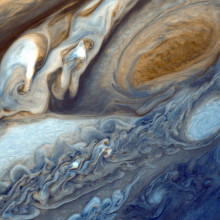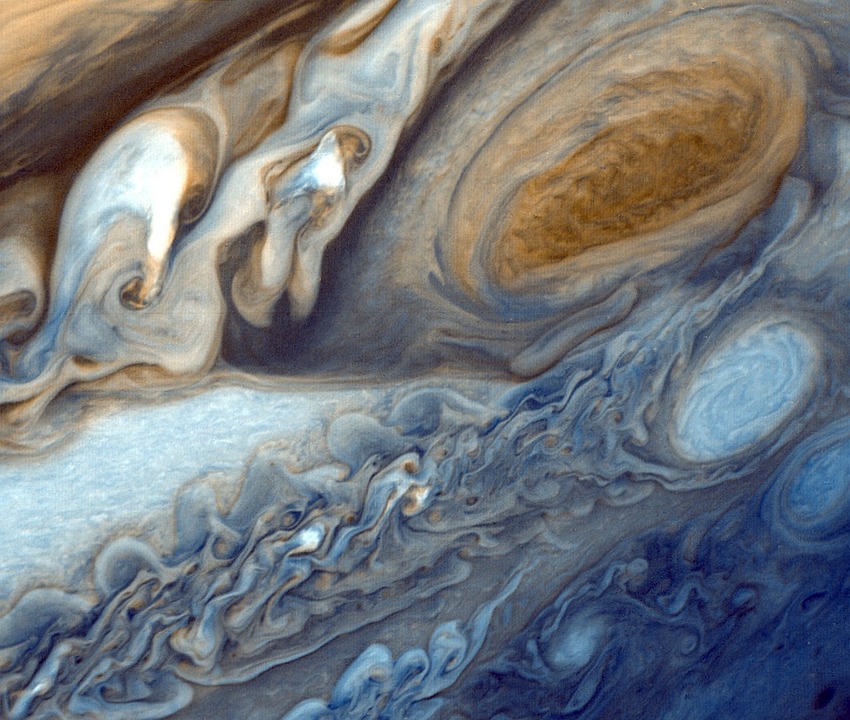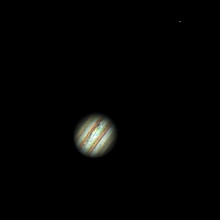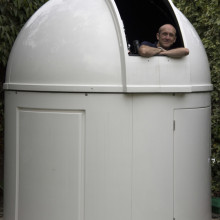Jupiter: King of the Planets
NASA's Juno probe has reached Jupiter after a five year battle through our solar system and is orbiting the gas giant. But now it's completed this death-defying stunt, what now? This month on Naked Astronomy, Graihagh Jackson is colluding with the king of the planets to find out what it's really all about...
In this episode

00:52 - Jupiter: The weird planet
Jupiter: The weird planet
with Dr Marc Rayman, NASA's Jet Propulsion Lab
With its strong radiation belts, polar auroras and red spot, Jupiter is a bit of an  enigma, as Graihagh Jackson discovers with Heather and Marc Rayman...
enigma, as Graihagh Jackson discovers with Heather and Marc Rayman...
Marc - Although some planets seem to be gassy, they aren't like the light, airy, and substantial gas we generally think of. On Earth, the weight of the air above you pulled down by our planet's gravity creates a modest pressure. This is about 1 kilogram per square centimetre. That's the mass of a big book, like a dictionary if you remember those from the 20th century, pushing down on an area about the size of a single Lego brick. We conveniently call it 1 bar.
Heather - That's Earth, but what about Jupiter?
Marc - In contrast to our planet, gas planets are composed mostly of gas. They're also gigantic and the weight of all that gas is tremendous. For example, Jupiter is mostly hydrogen and it is enormous, 11 times the diameter of Earth and over 300 times the mass. It may have a rocky core that's more than 10 times the mass of Earth. All that mass causes intense gravity, pulling downward on the gas which compresses it and creates fantastically high pressure.
Heather - More pressure than one dictionary, how many though? A hundred? A thousand? Ten thousand?
Marc - If you ever tried to land on a gassy planet, you would be subjected to pressure beyond anything you can imagine. As you descended below the colourful gas clouds, the pressure would grow and grow, rising to 1 million bar, at a depth of about 10,000 kilometres.
Heather - One million dictionaries.
Marc - You would be immersed in a sea of hydrogen so dense that it's more like liquid than gas. At 20,000 kilometres, the pressure is around 2 million bars. That's 2,000 times greater than the highest pressure found on Earth in the Mariana Trench in the deepest part of the Pacific Ocean.
Heather - Two million dictionaries.
Marc - The hydrogen is compressed so hard that the electrons are squeezed off. The strange condition makes the hydrogen metallic, but going still deeper, the pressure would continue to skyrocket, exceeding perhaps 40 million bars at the rocky core, more than 60,000 kilometres deep.
Heather - Forty million dictionaries.
Marc - If you ever tried to land on a gassy planet, you would not even make it to a few hundred kilometres. Your spacecraft,and you, would be utterly destroyed, squashed by the crushing atmospheric pressure, long before you found the core. So, you might sink to the core, but only in the form of squished atoms.

04:43 - Juno rockets to Jupiter
Juno rockets to Jupiter
with Jack Connerney, NASA's Jet Propulsion Lab
Juno rockets to Jupiter and deputy principle investigator of the mission, Jack  Connerney, explains to Graihagh Jackson why they called it Juno...
Connerney, explains to Graihagh Jackson why they called it Juno...
Jack - There was no fight over the name, and I'm not exactly sure where Juno originated but it was a very clever name for the proposal. It refers to the goddess or wife of Juno. Juno was, of course, guilty of straying a little bit in his marriage and apparently raised clouds to obscure his activities from his then wife the goddess Juno. She caught onto this very quickly and, using her special powers, she could see through the clouds and discover what Juno was up to... Lord knows he probably paid a dear price!
So the name Juno basically refers to that mythology and the ability to peer through the clouds and see what's going on inside Jupiter.
Graihagh - Tell me the story of the Juno mission. How and why was it dreamt up in the first place?
Jack - The Juno proposal was first put forward in the early part of this century. It really goes back in time to George Cisco's original study back in the mid-1980s. So even though we've been working on Juno for almost 15 years now, it really grew from a seed that was planted in the mid-1980s.
Graihagh - You must be pleased and proud that it's finally come into fruition?
Jack - Yes, it's been a long time coming!
...Laughter
Graihagh - Back to the mission at hand - given that it's been a bit of a slog to get off the ground, what is it about Jupiter that Jack and co are excited about finding out?
Jack - Jupiter is essentially the repository of what was left over after the formation of our Sun and it hold within it the secrets of solar system formation. And, of course, all the recent discoveries of planets around other stars has kind of given a rebirth to the whole idea that we need to understand how our solar system formed and the best way to do that is to go to Jupiter and understand its composition and its evolution, and so that's part of the wind in Juno's sails.
Graihagh - I wonder if you can just sort of paint me a picture of the journey from Earth, if you like, and what sort of death defying things it's had to do in order to make the mission possible I suppose?
Jack - Well let's see. We launched this spacecraft actually in August of 2011 from Cape Kennedy down in Florida, and I remember that well, it was a very, very hot down there. Then the spacecraft went out and ventured just beyond the asteroid belt and did a deep space maneuver that would target it for a rendezvous with Earth, and that flyby gave us a little bit of momentum to get us out to Jupiter in a very fuel efficient way.
It's kind of interesting the amount of spacecraft that we eventually will get into our 14 day orbit will weigh about 3,500 lbs. Before we did the burn to get into orbit, we weighed a little over 8,000 lbs. And then looking back in August 2011, the amount of mass that we had to lift off the Earth to do that was about 1,250,000 lbs. So the majority of the spacecraft that we sent out there was actually fuel.
Graihagh - Wow! And what is it precisely that you're mapping - what is the data that you're expecting back?
Jack - Well there's a lot of instruments on this spacecraft; there's nine different science investigations and each investigation usually has a couple of instruments. So we record the magnetic field as we pass by the planet; that's the investigation that I lead and when we have built up a map of all these magnetic field observations we'll create a very detailed model of the magnetic field and see if we can't extrapolate that down into Jupiter to find out where it is generated and how a dynamo works.
We also carry another investigation called a microwave radiometer that looks at the radiation coming out of Jupiter. And by looking at that radiation as a function of the wavelength of the radiation and from where it originates, you can infer what the abundance of water an ammonia is in the atmosphere, and that's a very important element in trying to understand how Jupiter formed.
And we also do a gravity experiment and, of course, we do that by tracking the radio signals from the spacecraft and that tells us how the spacecraft orbit is perturbed by gravity.
All this goes into building a comprehensive model of Jupiter's interior and an evolutionary model of Jupiter from the time of it's birth 4½ billion years ago.
Graihagh - It sounds like a lot of information to take in, and send back, and also analyse and interpret. So when can we start expecting to hear about what you guys have found?
Jack - Well, so far I've only told you about half of it. Those three investigations are the ones that focus primarily on the interior. But we also have a very impressive complement of charged particle instruments: there's a waves experiment; we have a education public outreach camera; we have both an infrared and a ultraviolet imaging spectrograph.
The short answer would be that I'm sure that we'll see a lot of really interesting discoveries and results coming out almost immediately after a few of these orbits at the end of the year. While other science results will come out later when the mission has accumulated this dense net of observations, and that will take about a year and a half, I think.
Graihagh - Finally, I wonder if you could just tell me about the end of the mission - what's going to happen and when is that?
Jack - Ah well, the end of the mission is the interesting part! The nominal mission calls for 37 orbits. We are flying in a very hostile radiation environment, and radiation is not only bad for people, but it's bad for sensitive electronics.
So in order to protect the vital organs of the spacecraft, by which I mean the avionics and the instrument electronics, we put all of that stuff into a vault. It's a cube a metre on the side and its half inch of solid titanium, and that will reduce the radiation environment by a factor of almost a thousand. But even still, after 37 orbits, we will have accumulated quite a heavy dose of ionising radiation. Now we have a safety factor, a margin, that assures us that we should be able to operate the spacecraft and the instruments successfully for the 37 orbits. But NASA has a requirement and the requirement is that we do not contaminate the satellite Europa.
The non-emission plan has us performing this deorbit maneuver while we can still control the spacecraft. So there is another possibility that is under study now that would allow us to extend the mission lifetime by a few orbits at a time. And basically, the way that works is that as long as we control the spacecraft, we can put it into an orbit that we can demonstrate will decay into Jupiter over a series of n-orbits - you can pick any number n: 10, 20, whatever. And as long as you can command the spacecraft, you can keep kicking the can down the road. So, conceivably, we could get quite a few more orbits and more science return out of the mission in that way.

14:00 - Photographing the gas giants
Photographing the gas giants
with Roger Hutchinson, Astrophographer
Roger Hutchinson takes Graihagh Jackson through how he photographs the night sky ...
...
Roger - Well, when I was a kid - I grew up in the 70's and that was right at the tail end of the Apollo programme. So the moon landings and everything, as a young boy, really inspired me and an interest in space developed. And then as I got a little bit older, probably with the encouragement of my dad, I built a telescope and I can still remember the first time I saw Saturn through telescope and that kind of hooked me. I did a lot of astronomy as a kid growing up and then went away to University, kind of dropped out for a bit - just got on with life, and then probably about 5 or 6 years ago I got back into the hobby. I've been obsessively photographing the skies ever since really.
Graihagh - You mentioned Saturn. You said you'll always remember the first time you saw Saturn. I wonder whether you could describe that moment a bit more for me?
Roger - Well, when you see it with your own eyes for the first time, it kind of blows you away. People think it's something that's been stuck onto the end of the telescope; they just think it's a little cardboard cutout or something because it just doesn't look real you know - it's mind-blowing really!
Graihagh - OK. I will add that to my checklist of things to do in life: catch a fish and eat it, see Saturn in the real flesh. I think that's the next one to do.
So tell me about Jupiter then? Have you photographed Jupiter much and I want to know is it disappointing to see?
Roger - No, I would say Jupiter is not disappointing! I have done a lot of photography of Jupiter. For planetary photography it's probably the easiest target because it's not called the king of the planets for nothing. It's big and it's an interesting sort of target as well because it rotates so quickly, the cloud patterns change. It's quite a dynamic target so it's a good one to cut your teeth on.
Graihagh - I came all the way to your beautiful house in the hope that we might be able to photograph Jupiter, and classically it's cloud in the U.K. What more would you expect?
Roger - In astronomy in Britain you've just got to develop a lot of patience and just realise that there'll be another opportunity some other time and just make the most of what nature deals you, but this summer has been particularly bad.
Graihagh - You say it's a write off, but I'm looking into your back garden as we sit in the conservatory now and I think the whole trip down from Cambridge has been worth it just to see... I mean I don't even know how to describe it, it's like a mini observatory in some ways - it's quite impressive!
Roger - Well I guess it's what people would picture if they were talking about an observatory; it's got a dome. So like anything with a...
Graighah - Seriously - I think you're underselling it here! It's a good two metres high, white and almost like a hidey house at the back of the garden.
Roger - It's been described as a minion, a rubbish bin, a portable toilet... all sorts of things. There's been a lot of comments about it
Graighah - Can you give me a tour?
Roger - Absolutely... So it's all plugged in in the hope that we'd see something but... Just watch yourself here as I have bashed my head on numerous times.
Graihagh - It's a really impressive setup.
Roger - It's currently pointing at Jupiter at the minute but you wouldn't know it
Graihagh - Does that mean you're sitting out here for hours on end or do you just hit click and then go to bed?
Roger - Well for planetary, you're actually shooting video, so you don't take individual images; you take a sequence of individual images. Basically what we call it is 'lucky imaging' because the sky and the atmosphere is very turbulent and the more you magnify it the more turbulent it becomes so, basically, it's what we call 'seeing'. Seeing is basically with front distortions in the atmosphere, so it's just like if you're looking at something under high magnification - it wobbles. What you want to do to counteract that is shoot something when it's really high in the sky so you're looking through less atmosphere, or you can use different wavelengths of light that are less affected by seeing. Or you could wait to get a really good night because that is the best thing to let nature sort it out for you.
So there are lots of websites that have jetstream predictions. So what you want is the wind speed of the jetstream to be low over the U.K., over where you're imaging. And then in general, it doesn't always hold true but, in general, if you've got light winds at ground level, light winds in the jetstream, then seeing is normally reasonably good.
So the best thing is to take in when everything works well for you. But we can help that along by using a non-visible wavelengths pass filter and what that does is if you think about the electromagnetic spectrum and you've got like red through to...
Graihagh - Like the rainbow...
Roger - Like the rainbow, basically. So red is a longer wavelength than green, which is a longer wavelength than blue. So what I do is image through a mono camera, so this is a black and white camera, and you image through a series of different filters. What we use is an infrared pass filter which filters out any wavelength shorter than 685 nanometers, so it's quite long wavelengths, and that is less affected by seeing - the shorter wavelengths are more affected by seeing.
So what you typically see when you're taking your images, you take a series of images; one through an infrared filter, which is not necessary if you want a colour image, you can just use a red and then a green, and a blue filter. But what you generally see is that the red filter image is less affected than the blue filter image by atmospheric seeing because red light has a longer wavelength than blue light so it kind of demonstrates the theory quite well.
Graihagh - You must have to brush up on your physics quite a lot here t work out how well to photograph these things?
Roger - You don't necessarily need to know the physics; you're just shooting through different filters but it's quite nice to know why your red image is much better than your blue image. But what we then tend to do is we'll combine the red, green, and blue images together to give you a colouridge and then we'll use the infrared image as what's termed a luminance layer, which is where all your detail is. So that sits on top and gives you all the detail, and all the colour comes from the red, green and blue images that you've taken through the relevant filters.
Oh, that was the dome moving...
Graihagh - It moves automatically?
Roger - Yes, it's tracking the sky as well as the telescope. So what that does mean to answer your earlier question, you can, if you're taking long exposure photographs of deep sky objects, you can set it going and go off and have a cup of tea in the warm.
Graihagh - And the roof will continue to move round?
Roger - And the roof will move around for you, yes. It does give you a little bit of shock sometimes if you're not expecting it or if you're leaning against it!
Graihagh - Rooky error!
Roger - I'd forgotten it was on actually. I'll turn it off because we're not actually looking at anything at the minute.
Graihagh - Back inside, Roger took me through the complicated imaging process he does to make these beautiful pictures. He really does make it look easy but actually, there's at least a good 45 minutes of tinkering around.
Roger - You take a lot of images over time and some are better than others and a lot of it, as I've said, is down to conditions that are basically beyond your control. Sometimes you just get a perfect night where everything just works well, works in your favour, all the equipment works well, and you get a really nice image at the end of it. It's about being patient, and plugging away, and not being too disheartened. It just that nice surprise when you get a really good result.
Graihagh - What image are you most proud of?
Roger - The one's I'm proudest of are probably some of the deep sky images because they do take a lot of time and dedication. But the ones I like the most and enjoyed taking the most are probably the transitory ones. The lunar eclipse that we had last September - it was just great for the weather to play ball because these things happen quite rarely, and so to be able to actually get them and image them is exciting and really pleasurable.
Graihagh - I can see... I can see you take great joy - watching your process and talking about it - I can see it gives you great pleasure.
Roger - Mmm. Absolutely! I can recommend it to anyone. You don't need to go mad and have your own observatory in the back yard to do it either. You can create really nice results with minimal gear.










Comments
Add a comment